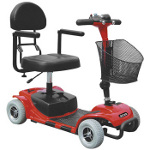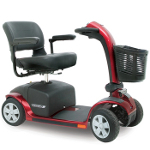The Wheelchair Guide
Your Wheelchair and Mobility Scooter Resource
What Are Mobility Scooters?
Tuesday, February 9th, 2010 at 10:30 am
 Moving around is often quite difficult for the elderly, especially among seniors who have arthritis. Since using a wheelchair can be quite strenuous, it is often not a good choice for seniors, especially those who intend to travel away from the home.
Moving around is often quite difficult for the elderly, especially among seniors who have arthritis. Since using a wheelchair can be quite strenuous, it is often not a good choice for seniors, especially those who intend to travel away from the home.
Mobility scooters provide a nice middle ground between an electric wheelchair and a regular wheelchair, while also often being better suited for outdoor use. This is because, in most cases, a mobility scooter is significantly less expensive than an electric wheelchair, so often the cost of a scooter vs a wheelchair is a big selling point.
The mobility scooter is not exactly a new medical device, with the first models being developed during the nineteen-sixties. However, it would not be until about twenty years later, during the nineteen-eighties, when their popularity really took off.
While the functionality they offer is similar to that of an electric wheelchair, adult scooters have a different design, with a longer base that has a set of handlebars in the front and a seat towards the rear. The electric scooter is controlled using the handlebars at the front, which is called a tiller, usually allows the scooter to not only be turned, but also the speed regulated and the control of any extras, such as lighting or horns.
Since the tiller is located in the front of the electric scooter, it can not be driven directly up to a table the same way you would an electric wheelchair. Instead, it is either necessary to exit the scooter and transfer to a chair or to drive the scooter up parallel to the table. To make it easier to transfer out of the scooter, the chair can be turned and some even come with automatic lifting chairs as well.
Different Types of Mobility Scooters
 There are many different models of mobility scooters, but they can typically be classified as either a travel scooter, heavy duty scooter, or standard scooter.
There are many different models of mobility scooters, but they can typically be classified as either a travel scooter, heavy duty scooter, or standard scooter.
Heavy Duty Scooters are the most powerful and are designed to support more weight, as well as for outdoor use. As a result, they usually have reinforced bumpers, larger wheels, stronger suspension, and many other features. However, as they are much larger than other types of scooters, a heavy duty scooter usually requires scooter lift to transport the scooter away from home, as well as not being as well suited for tight quarter indoor use.
Travel Scooters are basically the direct opposite of a heavy duty scooter, with the focus being on making the scooter as lightweight as possible, so that it can be easily transported. This means they have fewer features and everything, from the tiller to the seat is designed to be as light as possible. A travel scooter can be taken apart easily and each individual piece is intended to be able to be easily lifted into a vehicle. Since a travel scooter is so light, they usually have the shortest per-charge range and a much lower weight capacity.
Standard scooters form the middle ground, trying to blend the right amount of features, with the overall weight of the device. As a result, they are not as easy to transport as a travel scooter, but have a larger range, more comfortable seating, and generally a number of comfort features. Usually they can be broken down into more manageable pieces, as can heavy duty scooters, but they are still much heavier than a travel scooter.
A Word About Wheels
Another way that mobility scooters are classified is by the number of wheels they have, specifically four wheel mobility scooters and three wheel mobility scooters. In the case of 4-Wheeled Scooters, there is a more even distribution of weight across the base of the scooter. This makes them more stable, as well as being better suited for larger weight capacities and outdoor use. For this reason, most heavy duty scooters are four wheeled.
Three wheeled scooters are not as stable, but they do have a smaller turning radius than four wheeled scooters. As a result, this makes them a better choice for indoor use. Also, since the front axle is smaller, they are also lighter, so many travel scooters use a three wheel design.